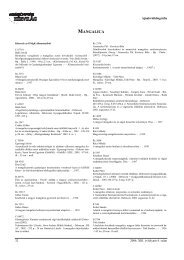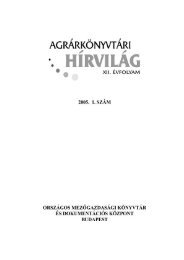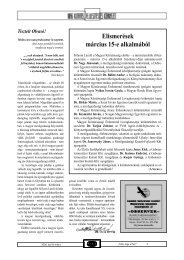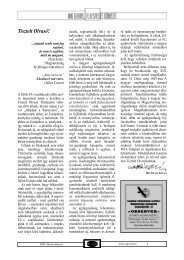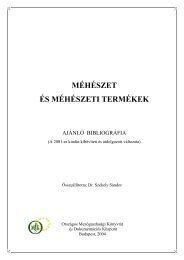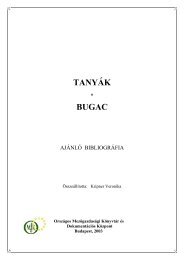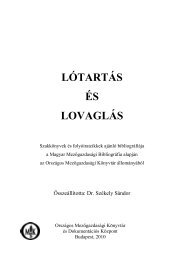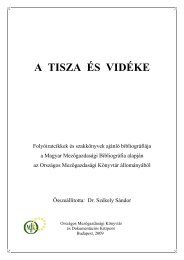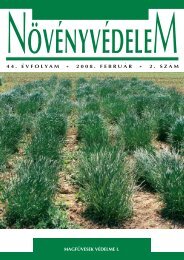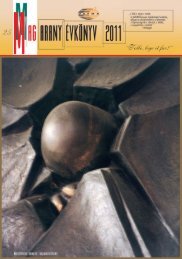hUNGARiAN AGRicUltURAl RESEARch
hUNGARiAN AGRicUltURAl RESEARch
hUNGARiAN AGRicUltURAl RESEARch
Create successful ePaper yourself
Turn your PDF publications into a flip-book with our unique Google optimized e-Paper software.
c., The vine stock themselves<br />
regulate the number of clusters,<br />
however as we remove young<br />
shoots at first in spring and just<br />
the remaining buds will produce<br />
and this is more closely optimized<br />
to the vines stock capacity than<br />
any other pruning methods.<br />
d., The desired shape of the<br />
stock could be maintained well<br />
with the strict process of bud<br />
selection.<br />
e., The vine physiologically<br />
will serve the required amount of<br />
photo synthetically produced<br />
organic matter to the fruit because<br />
of the fertile seed production and<br />
store all the required components<br />
in the wooden part which needs to<br />
support living. It has enough<br />
canopy to do so.<br />
f., Every year the old dried<br />
parts of the canes will partially fall<br />
out, however, of course sometimes<br />
it is necessary to remove<br />
dead wooden parts.<br />
aa., We always have enough on<br />
two year old parts to develop<br />
yearly shoots.<br />
bb., Fertility will be more<br />
even, only a short section of the<br />
cane matures well. Therefore it<br />
looks like two bud pruning<br />
method is applied sometimes.<br />
cc., There are no excessively<br />
vigorous canes on the stock.<br />
dd., We have high numbers of<br />
short internode canes.<br />
ee., As the canes are short and<br />
because their number is high and<br />
cluster development occur on it,<br />
thus they ripen very well.<br />
ff., These methods fulfill, as<br />
vine vigor is a vital part of<br />
maintenance and quality yield<br />
production, even if the quantity is<br />
great as well.<br />
Establishment of the<br />
Babo Branch Cordon System<br />
We begin by erecting a support<br />
structure. Support columns are<br />
placed three meters apart and three<br />
support wires are strung between<br />
Fig. 1: Vine-stocks in third year<br />
of BBCS cultivation<br />
Monterey, California vineyard<br />
Chardonnay grapes (year 2002)<br />
50% of canes have been pruned.<br />
We left vines 25 (35) cm apart<br />
reaching towards the ground.<br />
This fostered uniform appearance<br />
of new buds.<br />
the columns. One wire is strung<br />
on top of the columns (160 – 190<br />
cm high), the second wire about 30<br />
cm below, and the third about<br />
25–30 cm above ground. The top<br />
wire supports the cordon branch<br />
and the other two wires support the<br />
shoots coming from the cordon<br />
branch. During the first couple of<br />
years of cultivation we nurture<br />
vine-stock and cordon branch<br />
development; cordon branches<br />
will grow close to one another and<br />
eventually touch. At 8–10 cm<br />
apart on the cordon branches (at<br />
the nodes where shoots appear) we<br />
cultivate shoots to grow downwards<br />
and eventually reach the<br />
ground. In the following spring<br />
we remove about half of the canes<br />
that grew on the branches. Those<br />
canes that remain should be about<br />
25–35 cm apart; these we trim to<br />
25 cm above ground and fix them<br />
vertically to the support wires.<br />
(Fig. 1)<br />
Fig. 2: On harvested vines we<br />
find short branches in the spring<br />
of the fourth year of cultivation.<br />
Monterey, California vineyard<br />
Chardonnay grapes (year 2003)<br />
Branches on harvested vines are<br />
cut back to three bud-lengths.<br />
These now we call productive<br />
vines.<br />
We control yield by rubbing off<br />
light-colored (winter) buds. On<br />
vine-stock producing small clusters<br />
we leave more, those producing<br />
large clusters fewer light-colored<br />
buds. Width of the swath rubbed<br />
clean by purpose designed machinery<br />
is adjustable by positioning<br />
the appropriate brushes (Fig. 4)<br />
Near the rubbed off main<br />
shoots we find smaller auxiliary<br />
shoots. These will be barren<br />
higher up on the branch, but those<br />
near the ground will produce fruit.<br />
(Fig. 6) Fewer clusters aid<br />
fecundity of shorter branches.<br />
We leave harvested branches on<br />
vine-stock. (Fig. 2). In a few years<br />
these branches will grow short<br />
length fruit-bearing vines (Fig. 3).<br />
Sugar content of fruit and area of<br />
foliage will depend on how much<br />
we thinned out buds. Foliage<br />
should be kept thin to permit<br />
sunshine reaching the fruit, even at<br />
the cost of trimming new shoots.<br />
22 Hungarian Agricultural Research 2009/3–4



